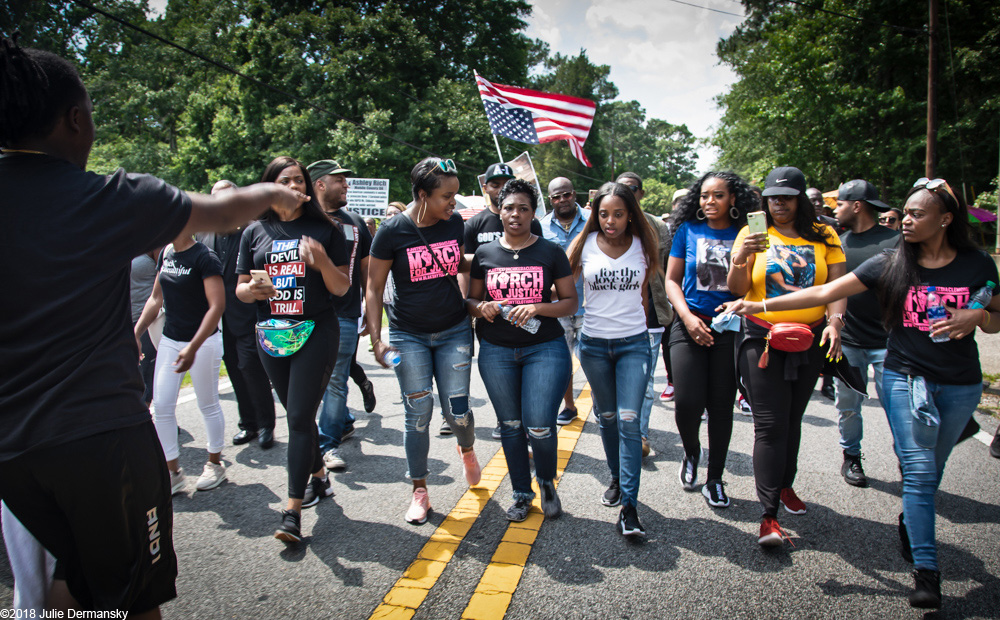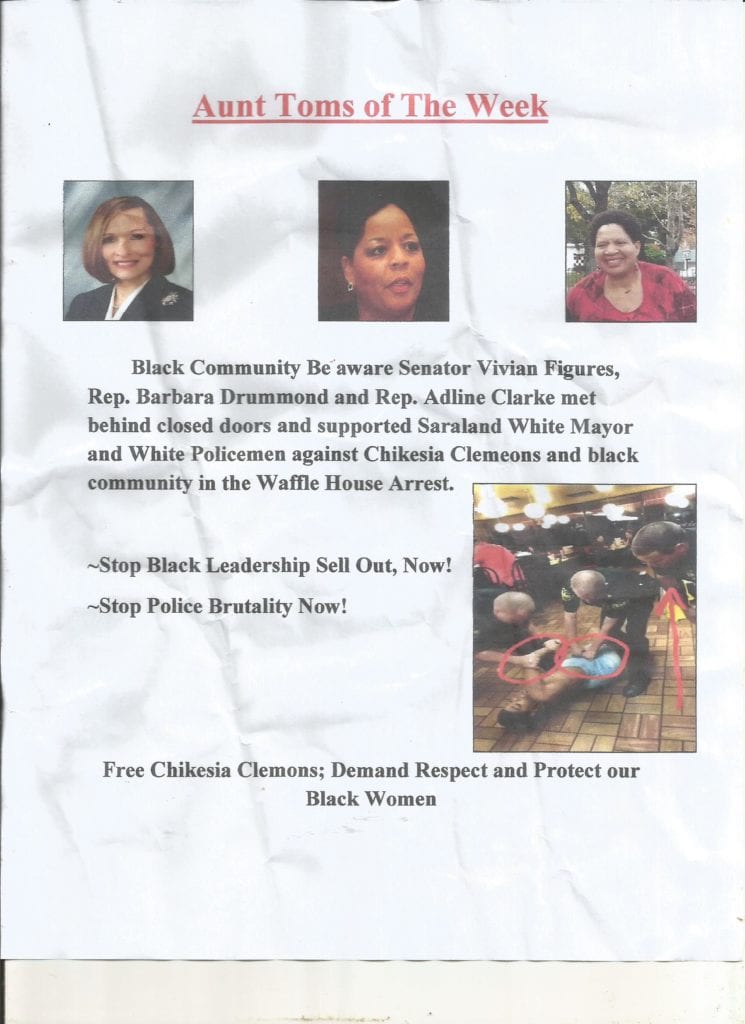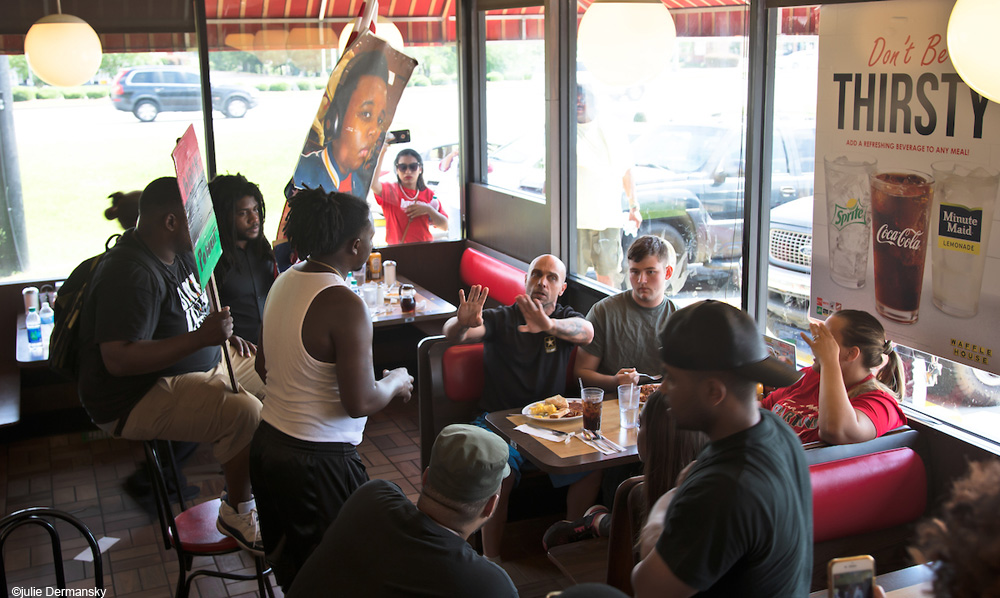
Chikesia Clemons in the middle of marchers protesting Waffle House in Saraland Alabama, May 20, 2018: Julie Dermansky
By David Underhill –
MOBILE, Ala – Only saturation in Clorox could create somebody whiter than me. By ancestry, upbringing and appearance I’m as standard Euro white as any American can be. Yet there I was—almost the only white face in a packed black church, in a black neighborhood squeezed between the railroad tracks and the swamp and known as the Blackjack, in the Mobile suburb of Saraland on the evening of the same day last month as the opening up the road in Montgomery of a grisly museum about America’s history of lynching.
It did not feel like an odd position to be in. For decades I had occasionally gone into the Blackjack on one project or another, I was welcomed when entering the church, I noticed a few folks I knew in the crowd and upfront conducting the meeting.
They were there because several days earlier a 25 year old black woman, Chikesia Clemons, had been thrown to the floor of a Waffle House in the commercial section of the city and stripped half-naked while being arrested by three Saraland policemen after some verbal spat with a waitress. A friend’s cell phone video of the incident went viral on social media. It looked eerily like historical accounts of victims dragged out of their homes in nightclothes or none by mobs and hauled off to lynching trees, as memorialized that day by the museum opening in the state capital.
Although this was not a church service, there was testimony and professions of faith that this time, at last, something good and hopeful would come out of something vile. The preacher and the head of the local NAACP presided at the front, but they said little except to coax the crowd to remain calm and respectful of each other.
A line formed in the center aisle, and people stepped forward one by one to give their opinions of what had happened at the Waffle House, what should be done about it, why it happened, how it resembled other incidents in nearby suburbs, in Mobile, across America—last year, 10 years ago, half a century ago. It was a graduate-level oral history seminar conducted by ordinary folks who’d learned a lot and forgotten little.
Then Al Sharpton starred at a rally in a downtown Mobile black church. He addressed charges that Clemons had come into the Waffle House drunk by saying if this is to be the standard for getting stripped and arrested, there’s gonna be an awful lot of naked folks in handcuffs on Saturday nights in Alabama. But this won’t happen, of course. She was treated like that, he said, because of who she is not because of what she did.
Her lawyers — she has at least two now and a legal defense fund has started — said the same. And besides, she wasn’t drunk, they say. Nor did she threaten, as some authorities claim, to get a gun and shoot up the place. Instead, the lawyers have statements from two customers, white, who were in the Waffle House during the incident. They did not notice drunken behavior or hear threatening language before the cops entered and slung Clemons to the floor.
These disputes over facts will continue in court. Clemons is scheduled for trial in June on charges of disorderly conduct and resisting arrest.
Trial By Social Media
Meanwhile, she is being tried on social media, since the traditional press is barely covering it at all. After every news report on a church meeting, rally or other protest by Clemons’ supporters the comment columns bristle with hostile responses, favorite ones swiftly attracting hundreds of “likes.”
Some of these comments simply accept the official version of events as true and draw conclusions from that: “Obey law enforcement or deal with consequences.” “Your treated the way you act.” “This had nothing to do with racism or hate. It had to do with alcohol abuse and idiotic behavior.”
Others are more menacing: “Shes lucky they didn’t shoot her for the threat.” “She is a joke and Al Sharpton should be ran out of the country.”
A few yearn for pain and damage. One said of the video posted by Clemons’ friend, “I kind of wish they would have had to taser her I would of sat there and watched that one over and over and over and over…”
And the local NAACP’s voice mail received this opinion of their support for Clemons: “I hope you burn in hell. God bless America. God bless Donald Trump. God bless our white country and f___ you.”
These angry or skeptical reactions come almost exclusively from whites. And the comments defending Clemons are mostly from blacks.
Corporate Culture Clash
Waffle House could stop much of this openly expressed racial animosity but has chosen not to.
After a recent racially tinged arrest of two customers at a Philadelphia Starbucks, the company apologized and took other corrective steps in conjunction with local officials. The surrounding controversy soon evaporated. Several years ago Chick-fil-A got into a public tussle over gay marriage, then thought better about pursuing that, and backed off. Denny’s turn came in the 90s. After resisting discrimination complaints by black customers, the restaurant chain agreed to a settlement and benefited by doing so. Cracker Barrel put itself through a similar wringer before arriving at a similar result.
Maybe Waffle House will never take this course. From Georgia roots it has expanded across the country with a couple thousand stores. But they are concentrated in the southeast and not in black urban neighborhoods. They tend to be in suburbs and small towns, and their clientele reflects this.
A cynic might wonder whether Waffle House has taken the Chikesia Clemons affair as a branding opportunity for that clientele, a subtle way of declaring: This restaurant is for You, not for Them. Soon after the event the company said it had reviewed security videos and witness statements and concluded that her arrest by Saraland police had been “necessary and appropriate.” Waffle House has not wavered from that position.
The consequence is persistent protests in the Mobile area and elsewhere, calls for a boycott of Waffle House, and a retort of Boycott Their Boycott. Waffle House must be losing some black business locally, perhaps nationally too. And it could be gaining white business. If so, the branding may be taking effect, whether intended by corporate headquarters or not.
Fort Suburbia
Saraland would be an ideal ally for such an effort. Typically for American cities, Mobile is rimmed by suburbs with different demographics. Immediately north of downtown is Prichard, originally a white working class municipality, now almost all black. North of that is Chickasaw, once quite white, now turning partly black. North of that is Saraland, with about 14,000 people, approximately 85 percent of them white according to the census, and inclined to stay that way.
But it is not an elite suburb. Those are across the bay from downtown. Saraland is a refuge for whites able to escape from Prichard and Chickasaw but lacking the social and financial means for the leap to the far side of the bay or to the downtown historic mansion zones. It contains exceptions, of course, but this is Saraland’s main trait.
Ten years ago the city decided to insulate itself by separating from Mobile county’s public school system and forming an independent district. This was widely seen as an attempt to prevent blacks in neighboring communities from infiltrating Saraland — and was strenuously denied by advocates for the separation. They just wanted the best possible education for local students.
But the split fed the suspicion that everything happening in Saraland includes some racial angle, regardless of denials. The rough arrest of Chikesia Clemons inside the Saraland Waffle House was certain to get swept into that tangle.
Deaf Mute Politicians
These volatile features of the dispute have turned most politicians into deaf mutes. Saraland city officials have said little beyond routine support of their police force. Newly elected U.S. senator Doug Jones, whose victory last year relied to some extent on black women and others knocking on doors and getting voters to the polls, has said nothing about the controversy. African American politicians have also mostly been mute, although one state representative, Napoleon Bracy, has spoken at rallies for Clemons and advocated a Waffle House boycott. State Senator Hank Sanders has also appeared at one event in support of the cause.
But leaflets left on cars outside one of those church meetings called three black women legislators Sell Outs. It claimed they “met behind closed doors and supported Saraland White Mayor and White Policemen against Chikesia Clemeons”. And it baptized them “Aunt Toms of The Week”.

Whether they actually did this or not, their absence from the public events defending Clemons has left the leadership to others. This has included many local young people, mostly black, some white. And allies have arrived from elsewhere—veterans of the Missouri protests over the police killing of Michael Brown, a couple leaders of the national Womens March that greeted Donald Trump’s inauguration.
Their presence at a protest march across Saraland in late May prompted a community organizer to delicately observe that “Some of our local intersectional feminists are disappointing those of us who have stood with them.”
It was a fair complaint. Local white progressives cheered last year when solidly Trumpish Mobile county flipped to Doug Jones in the senate election. But, like the politicians, these progressives have steered away from involvement in the Clemons affair.
Everybody understands that it poses the same lingering questions and stirs the same anxieties as the lynching museum in Montgomery. Some, like the hostile commentors in the media columns, welcome this and would joyously enlist in another Civil War. Others hope, contrary to history and evidence, that these troubles will vanish if ignored or that they can move to a farther suburb where the ills of the city won’t follow.
Who Is We?
The black response to such attitudes mirrors them. The meetings, rallies and demonstrations have echoed with calls for what “we” must do to defend “our” black women and how “we” must create “our own” businesses so “we” don’t have to rely on “theirs”.
“Protect black queens, by any means!” dozens of demonstrators chanted as they marched across Saraland last week toward the Waffle House. They jammed into the small cafe and filled it also with chants of “No justice, no profits” and “This is what democracy looks like” and “Shut it down!”
A few white customers left, shouting “White power!” and giving single-finger departure salutes. Some youngsters had come on the march, and a cry went up to get the children out of the building, like something bad was about to bust loose. But a Prichard city councilman, Lorenzo Martin, shuttled between the protesters inside and the arriving cops outside. He arranged a temporary peace, and the marchers filed out to a grassy patch to reassemble and eventually dissipate, swearing to return.
That jumble at the Saraland Waffle House serves as a emblem of America. Racial frictions rubbing against tense communities trying to keep their social and economic status from deteriorating, while others elsewhere glide happily along, and those on the front lines of these gritty struggles are trying to patch together a series of shaky truces.
Something similar to this Waffle House scene is likely for Clemons’ trial —unless the city and the company accept the main demand of the protests, dropping the charges against her, which is unlikely.
That leaves the difficult issues unsettled, particularly the question of Who Is We? In the absence of reliable white allies, black talk of “we” and “us” becomes normal and necessary. This leads to further separation with even more “we-ness” and “us-ness” on both sides. The outcome of that is more of the same, seemingly forever — especially when it gets boosts throughout the society all the way up to the White House.
If there were an easy, obvious remedy for this it would have been enacted long ago. Without some miraculous transformation everybody is stuck with each other. “Can we all get along?” Rodney King asked after Los Angeles burned in 1991 following the acquittal of cops who had beaten him nearly to death during a traffic arrest.
Eradication would be a tempting solution for some. But besides being hideous it doesn’t work. Such brutalities are always incomplete and they leave greater grievances than they remove.
The only sane alternative to that is getting along together and recognizing the whole community as “we”. This is not expected soon.
A state senator from Selma, Hank Sanders, came to town for the rally before the march across Saraland. He said he has been fighting this battle for 50 years and he “may have to fight another 50 years.”
Perhaps he’s an optimist. Short of something even worse happening, it could turn out that 50 years from now another oral history line will form down the center aisle of a church and another seminar will add Chikesia Clemons’ arrest to the catalog of things never forgotten and never fixed.
In the end, President Donald Trump’s stance allowing public expressions of racism only feed the beast. Like Newton’s Third Law of Motion in the social realm, for every action there is an equal and opposite reaction. Allow racism. Expect an uprising in defiance of it.

Upset diners in the Saraland Waffle house as protesters chant in the restuarant in support of Chikesia Clemons: Julie Dermansky













